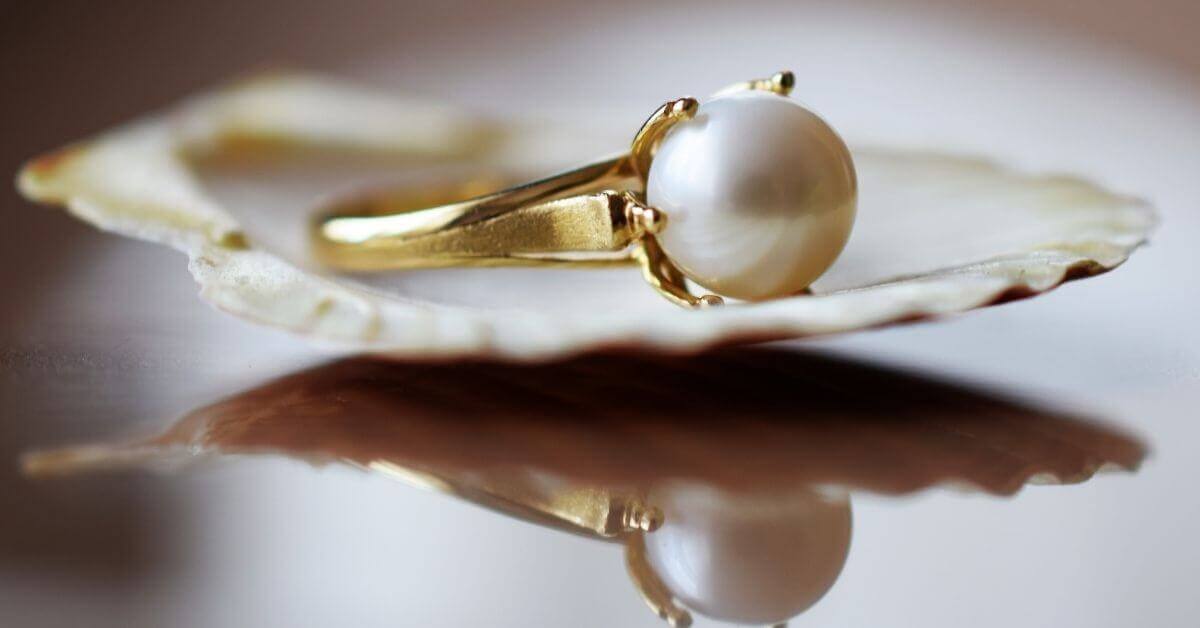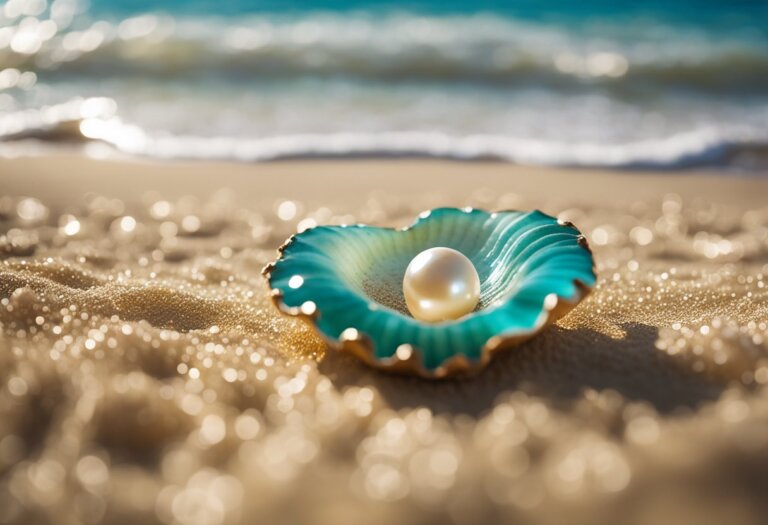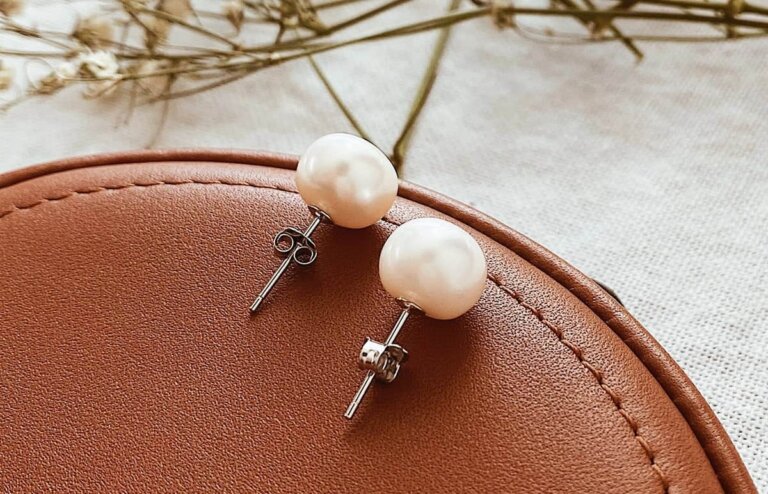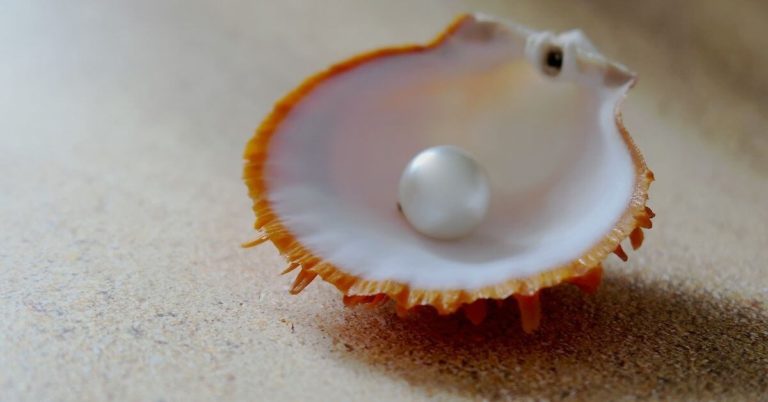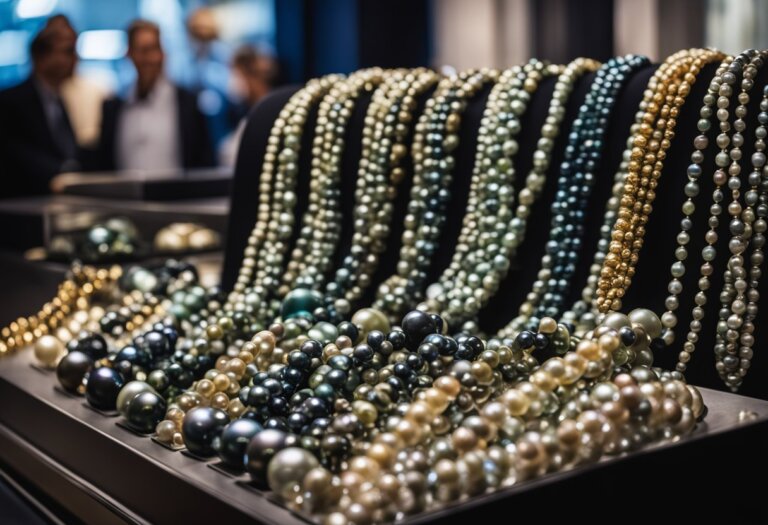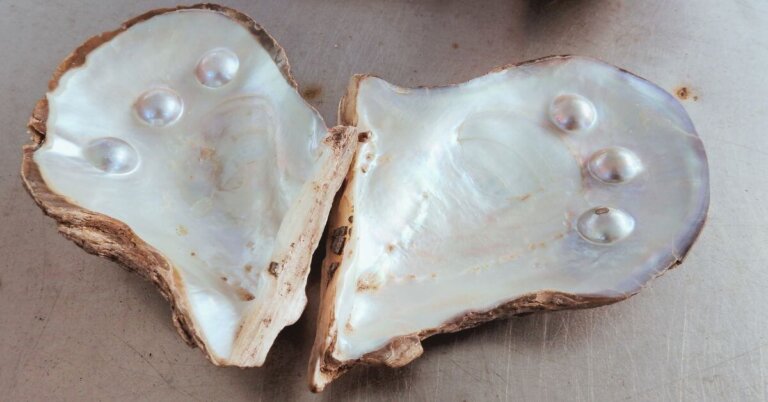Types of Pearls: Navigating the World of Lustrous Gemstones
Pearls are among nature’s most exquisite bounties, offering a range of colors, shapes, and sizes that are as diverse as they are beautiful.
When you think of pearls, you might instantly envision the classic white orb adorning jewelry, but there’s a vast world of variety to discover.
From the classic luster of natural pearls, found by chance within the soft tissue of a living mollusk, to the carefully nurtured beauty of cultured pearls, each pearl type has its unique charm and value.
What Are Pearls?
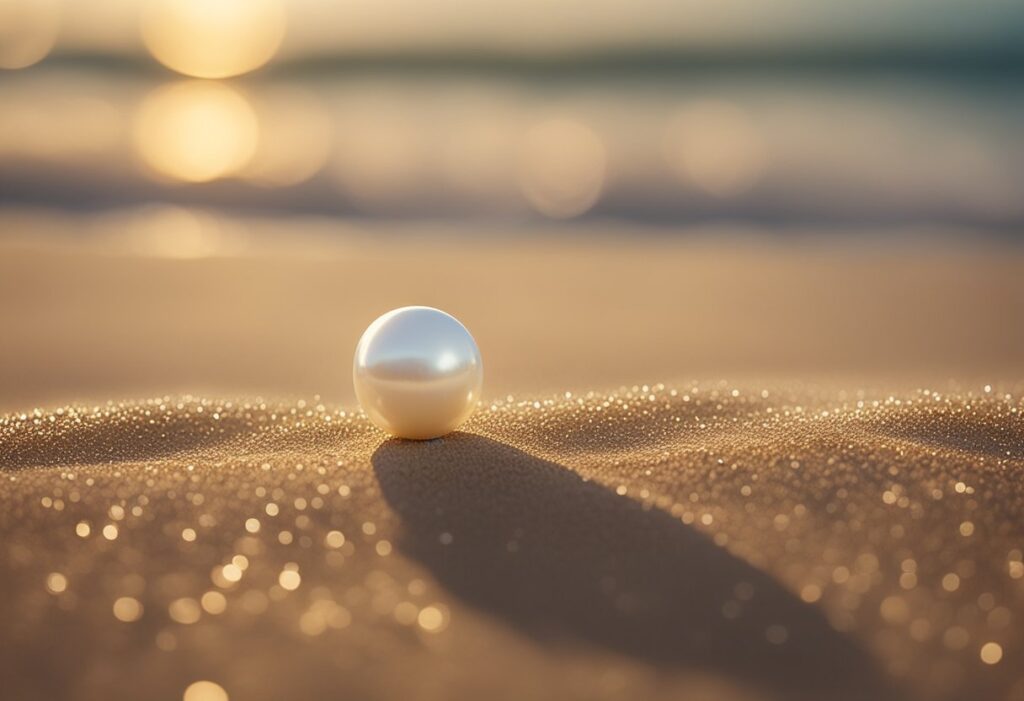
Pearls are the only gemstone that is produced by a living organism. They are created when a mollusk, such as an oyster or mussel, is irritated by a foreign object that gets inside its shell. This could be tissue graft from a donor mollusk, invading parasites or a tiny biological substance, but whatever it is, the mollusk perceives it as a threat to its well-being.
To protect itself, the mollusk secretes a substance called nacre, which it layers around the foreign object. Over time, this nacre builds up and forms a pearl. The process of pearl formation can take years, and not all mollusks will produce pearls.
Types of Pearls
When you’re considering purchasing pearls, knowing the different types can greatly influence your decision. From the coveted Akoya to the unique colors of Tahitian pearls, each type presents its own set of characteristics.
Freshwater Pearls
Your most versatile option, Freshwater pearls are predominantly harvested in China’s lakes and rivers. They offer an impressive size range, often between 2.0mm and 12.0mm, with exceptional pearls reaching up to 15.0mm. Colors span from classic white to natural pastel pinks, peaches, and lavenders. They are also one of the most durable pearls available due to their nearly solid nacre composition.
Akoya Pearls
Regarded as the classic pearl, Akoya pearls symbolize elegance. With origins in the cooler waters of Japan and China, these pearls shine with a high luster. Size varies from 2.0mm to 10.0mm, with white, silvery-blue, and golden tints being the most common. If you’re seeking traditional round pearls, Akoya is your ideal choice.
South Sea Pearls
Known as the “Queen of Pearls,” South Sea pearls are the largest, making them the pinnacle of luxury. Grown in Australia and the Philippines, they range from 8.0mm to 20.0mm. White South Sea pearls emerge from the Silver-lipped Pinctada maxima oyster, while Gold-lipped varieties produce golden hues. Their size and natural, luxurious colors make them stand out.
Tahitian Pearls
Imagine wearing the exotic beauty of the sea with Tahitian pearls, famous for their natural black color. Cultivated in French Polynesia, they boast sizes from 8.0mm to over 15.0mm, with a typical grey body adorned with vibrant overtones. Round Tahitian pearls are a rarity, making them a collector’s delight.
Keshi Pearls
Keshi pearls are non-nucleated pearls typically formed as by-products of pearl cultivation, offering unique shapes and luminous luster. Though smaller, they are cherished for their organic shapes and are a byproduct of both freshwater and saltwater environments.
Sea of Cortez Pearls
The Sea of Cortez pearls are rare gems, produced by the only pearl farm in the Gulf of California, Mexico. These pearls are known for their extraordinary colors and are often found in larger sizes, enhancing their uniqueness.
Blister or Mabe Pearls
Blister pearls or Mabe pearls are cultivated attached to the inner shell of the oyster, leading to a hemispherical shape. They are an affordable alternative, perfect for earrings and rings where the flat back can be an advantage in the setting.
Baroque Pearls
Each Baroque pearl is a one-of-a-kind shape, ranging from slightly off-round to completely abstract. Their unique free-form shapes make them favored for distinctive jewelry designs.
Seed Pearls
Finally, Seed pearls are small pearls, often used in antique jewelry. They add a delicate elegance to detailed pieces and are typically used in clusters for a textured, intricate effect.
Pearl Characteristics
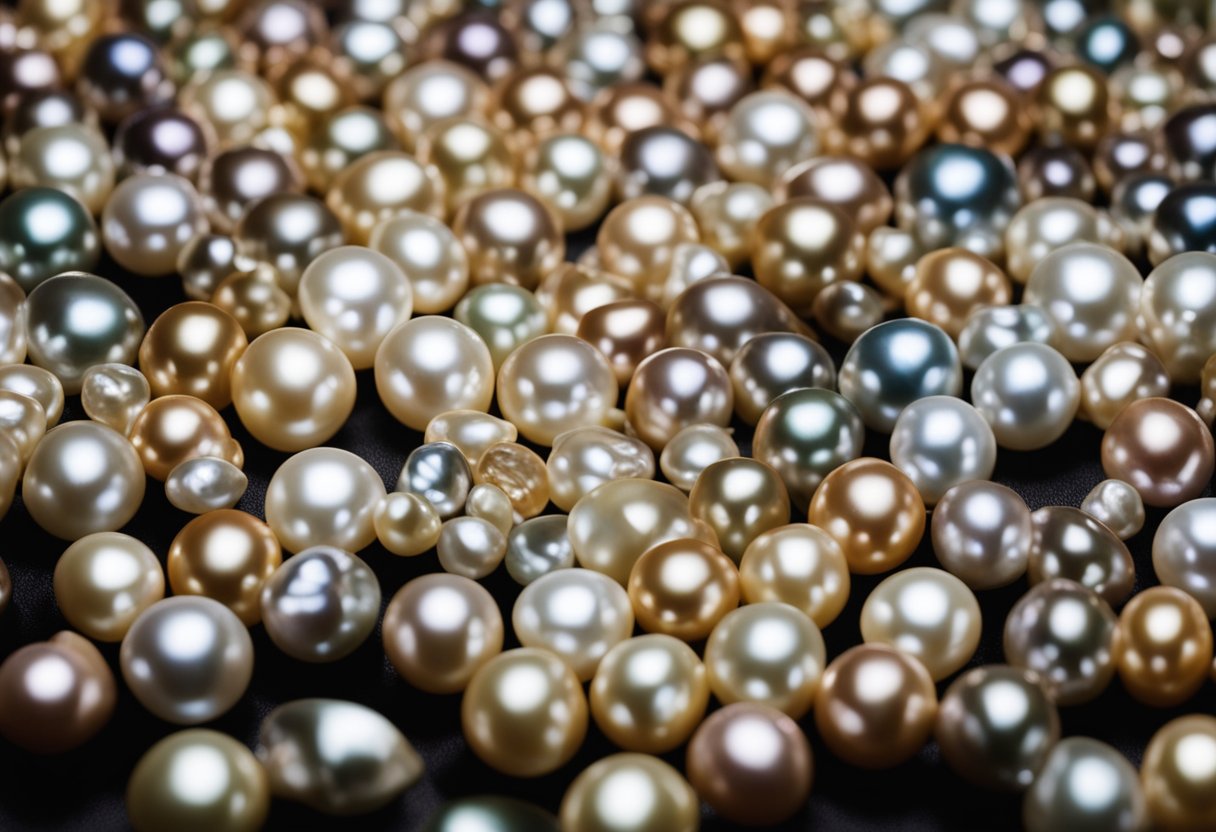
Pearls possess a unique allure, each with distinct features such as size, color, luster, and shape, setting them apart as gemstones sourced from living creatures. Their value is influenced by these traits, with South Sea pearls being among the most esteemed for their impressive size and rarity.
Colors and Overtones
Pearls come in a vast array of colors ranging from classic white, cream, and pink to more exotic shades like green, purple, and silver. Black pearls, particularly Tahitian pearls, can exhibit tantalizing overtones of blue, green, or grey. These colors are naturally occurring, and the presence of distinct overtones can enhance a pearl’s desirability.
| Common Pearl Color | Typical Overtones |
|---|---|
| White Pearl | Pink, silver, cream |
| Black Pearls | Green, blue, purple |
| Cream | Gold, pink |
| Pink | Lavender, peach |
| Silver | Ashen, blue undertones |
Shapes and Surfaces
The shape of a pearl significantly influences its appeal and value. While round pearls are highly prized for their symmetry, other shapes like oval, teardrop, and especially baroque—irregular and unique—add to the diversity. The surface should be smooth to the touch, and a pearl’s luster should be lustrous and not dull. Mother of Pearl, while shining with iridescence, differs as it is thinner with fewer nacre layers, unlike fully rounded gems.
Here’s a concise comparison of common pearl shapes:
| Pearl Shape | Description |
|---|---|
| Round | Perfectly spherical, classic |
| Oval | Elongated, symmetrical |
| Teardrop | Rounded at the base, pointed at one end |
| Baroque | Non-symmetrical, unique and often irregular |
In your journey to select the perfect pearl, consider these characteristics with a discerning eye, knowing each detail contributes to the pearl’s overall beauty and worth.
Pearl Culture and Origin
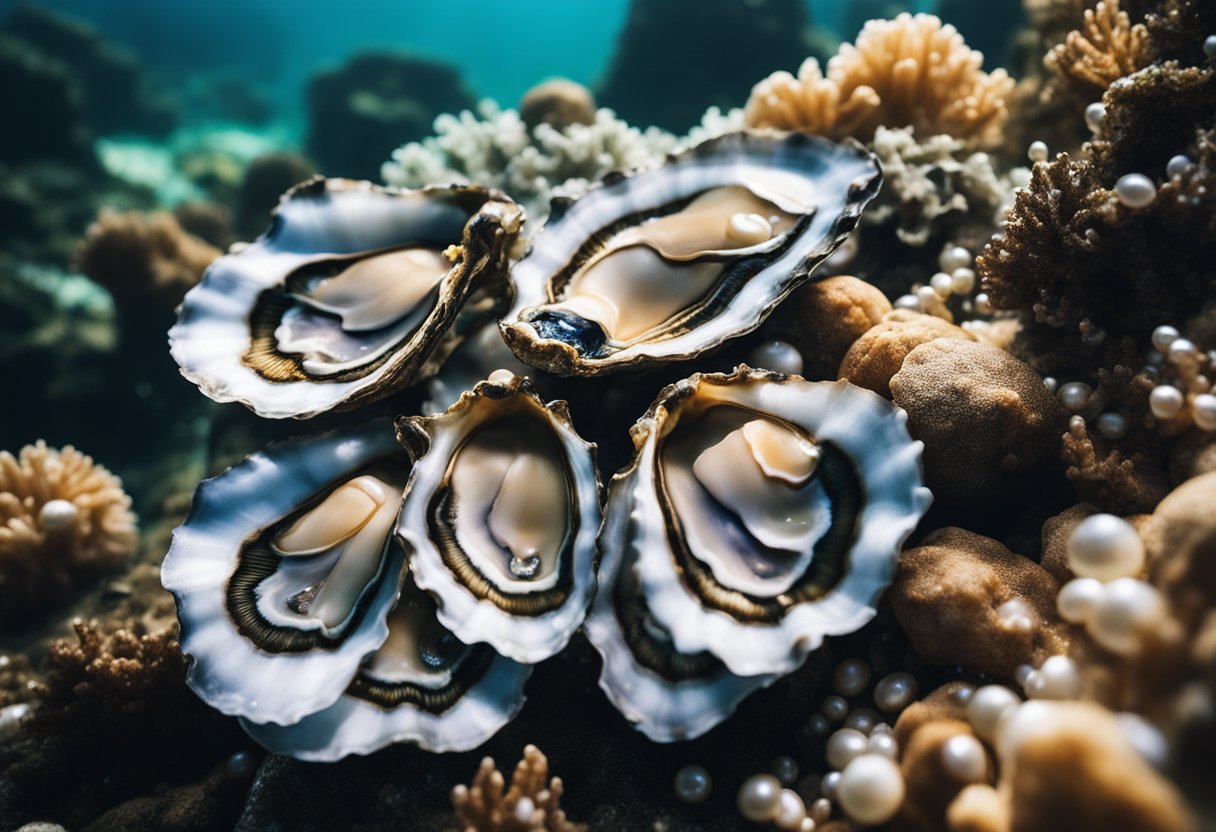
Pearl cultivation has revolutionized the gem industry, with practices that combine delicate craftsmanship and rigorous science. This intricate process results in the lustrous gems you know as cultured pearls, emerging from far-reaching corners of the globe.
Culturing Process
Culturing pearls begins with the nucleus-implantation technique, which marks the start of a pearl’s life.
- Technicians implant a small shell bead and a piece of mantle tissue into a living mollusk. This bead acts as the nucleus, around which the mollusk secretes layers of nacre, giving birth to a pearl.
- Care is taken not to open the oyster shell too wide or it can lead to a rejected nucleus.
- The mollusks will then be nurtured in mesh pockets under the sea, swinging from floating rafts. They feast on natural nutrients from the ocean, and over time, they coat the implanted bead with iridescent nacre.
- These oysters or clams will be seasonally moved to optimal waters, regularly cleaned, and safeguarded from natural threats until harvest.
Cultured Pearl Development Stages
| Stage | Process |
|---|---|
| Implantation | Insertion of bead and tissue into oyster |
| Growth | Oysters nourished in natural habitat, secreting nacre |
| Monitoring | Oysters are maintained and protected until pearls mature |
| Harvesting | Pearls are extracted and undergo thorough quality checks |
| Post-Harvest | Pearls are cleaned and prepared for use in jewelry |
Geographical Origins
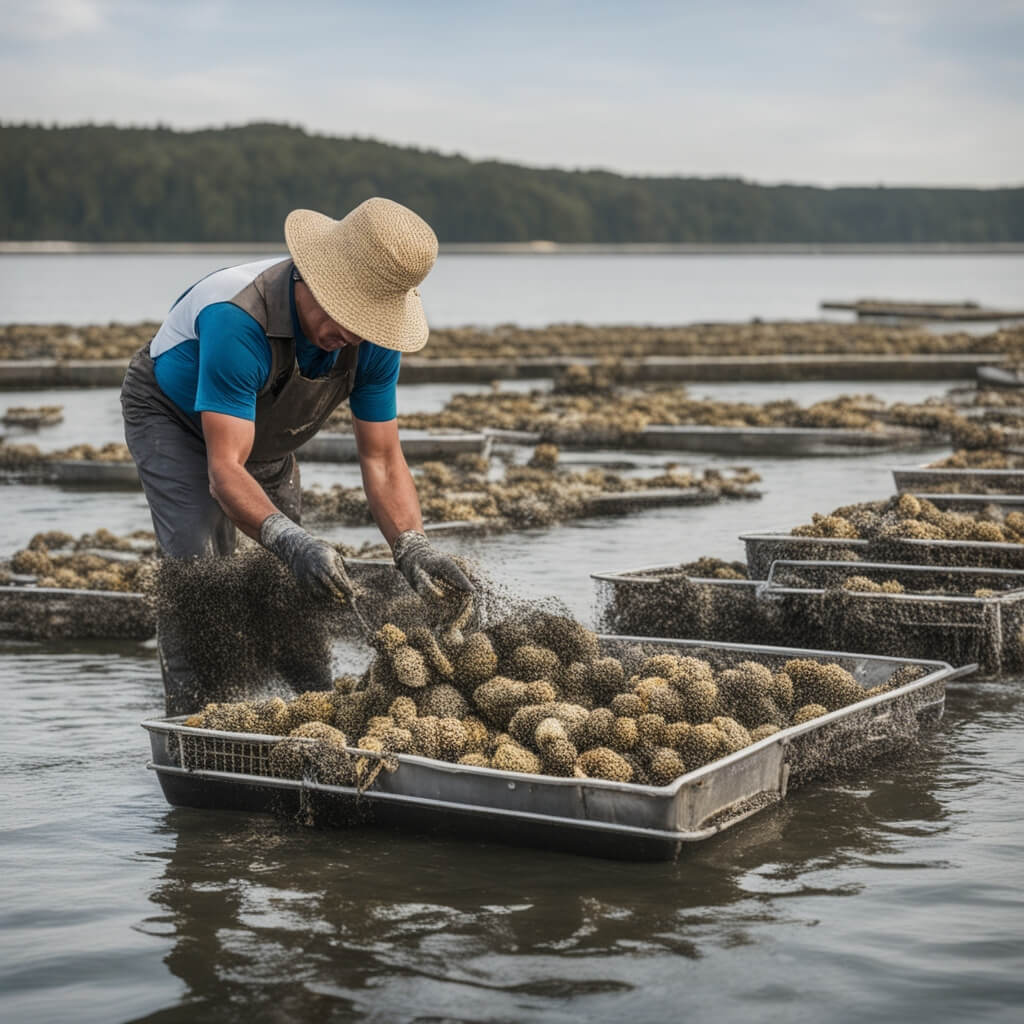
Cultured pearls spring forth from Pinctada oysters and freshwater mussels nestled in various parts of the world.
- Australia, Indonesia, the Philippines, and French Polynesia are renowned for their saltwater varieties.
- Japan, however, holds a special place in the pearl industry for its cultivation of the famed Akoya pearls, known for their superior luster.
- China is a notable player for its high quality and highly affordable freshwater pearls.
Each region contributes uniquely to the pearl market with distinct types, sizes, and quality.
Cultured pearls’ origins not only speak to the diversity of beauty found in these gems but also to the cultural and environmental narratives intertwined with their creation.
Pearl Types by Region
| Region | Pearl Type | Characteristics |
|---|---|---|
| Australia | South Sea Pearls | Large size, white and golden hues |
| Indonesia | South Sea Pearls | Varied sizes, deep golden colors |
| Philippines | South Sea Pearls | Rich luster, creamy to golden tones |
| Japan | Akoya Pearls | Classic elegance, high luster, round shape |
| French Polynesia | Tahitian Pearls | Exotic black colors, unique shapes |
| China | Freshwater Pearls | Wide range of shapes, affordable |
As you explore pearls, understanding their cultured origins and geographical roots enriches the appreciation for these maritime treasures. Each region adds to the vast tapestry that comprises the world of pearls — a blend of nature’s artistry and human ingenuity.
Why are Pearls so Popular?
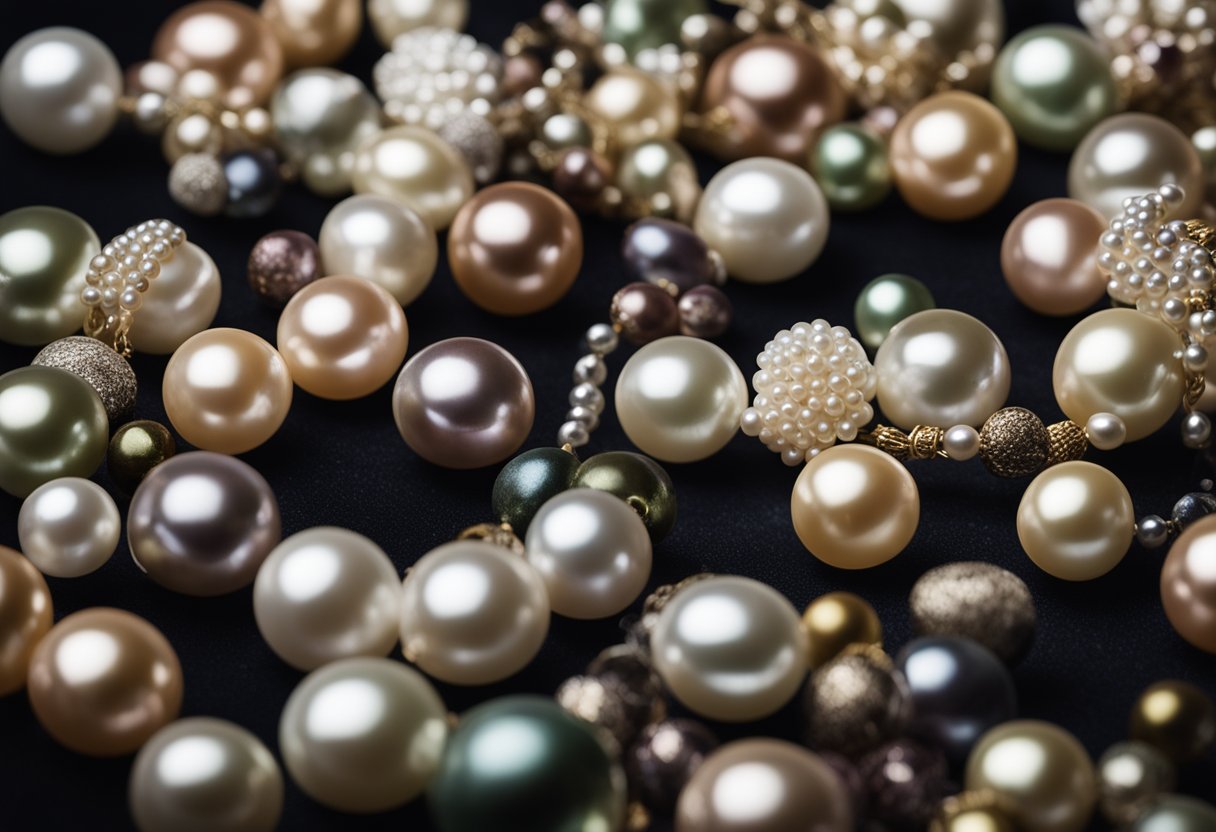
There are several reasons why pearls are appealing, including their inherent beauty, adaptability, and timeless quality. They are appropriate for a wide range of jewelry designs because they are available in a wide range of colors, shapes, and sizes.
In addition to their beauty, pearls have a rich cultural history and have been valued by many different cultures throughout time.
- In ancient Rome, for example, pearls were a symbol of wealth and status, and were often used to adorn the clothing and jewelry of the ruling class.
- In Japan, pearls were associated with purity and believed to have medicinal properties.
Today, pearls continue to be a popular choice for jewelry and accessories, and are often given as a gift to celebrate special occasions like weddings, graduations, and birthdays.
Whether you’re looking for a classic pearl necklace or a more modern and unique piece, there is sure to be a pearl that fits your style and personality.
difference between Saltwater Pearls and Freshwater Pearls
There are many difference between saltwater pearls and freshwater pearls.
- Saltwater pearls are pearls that are primarily grown in the ocean and are typically larger and more valuable than freshwater pearls.
- Freshwater pearls are pearls that are primarily grown in rivers and lakes, and are typically smaller and more affordable than saltwater pearls.
Other than the obvious difference here are a full list of difference between the different pearls that are cultivated in the different waters.
Saltwater Pearls
- Grown in saltwater environments, such as oceans or seas
- Typically more expensive than freshwater pearls
- Generally have a higher luster and smoother surface due to slower growth and lower production
- Cultured saltwater pearls are often round or near-round in shape
- Available in a range of colors, including white, cream, pink, silver, and gold
- Cultured saltwater pearls are often nucleated with a bead or nucleus
- Examples of saltwater pearls include Akoya, South Sea, and Tahitian pearls
Freshwater Pearls
- Grown in freshwater environments, such as lakes or rivers
- Generally less expensive than saltwater pearls
- Often have an irregular or off-round shape due to faster growth and higher production
- Can be nucleated with a piece of tissue or mantle from a donor mollusk, or nucleated with a bead or nucleus
- Available in a range of colors, including white, cream, pink, lavender, and peach
- Cultured freshwater pearls can be baroque, button, or round in shape
- Examples of freshwater pearls include Chinese freshwater pearls, Biwa pearls, and Keshi pearls
What Does Learning About The Different Types Of Pearl Mean To You?
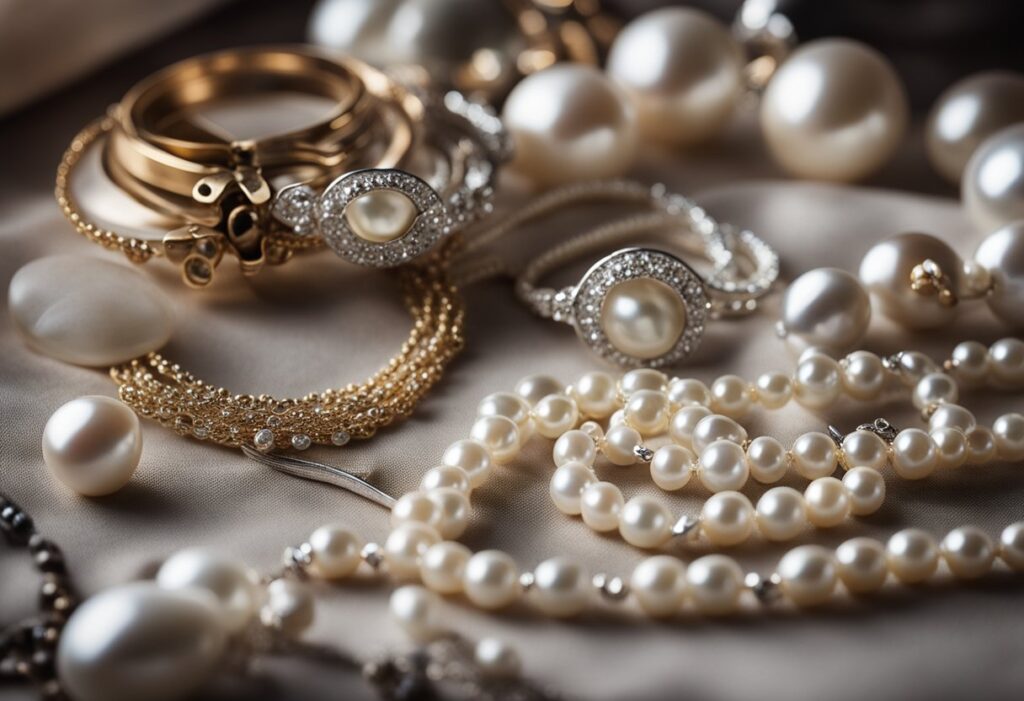
Understanding the differences between these pearls can surely enhance your appreciation for your jewelry.
Cultured pearls come in a myriad of types, such as the lustrous Akoya, the large and uniquely shaped Baroque, the darkly iridescent Tahitian, and the warm-toned South Sea pearls, each cultivated meticulously over time. The color palette of pearls extends far beyond the well-known white, showcasing shades of black, gold, pink, and even green.
Each type of pearl has its unique characteristics, and the distinct processes involved in their cultivation result in a range of colors, sizes, shapes, and luster.
Your choice of pearl jewelry speaks to your personal style as much as it does to the worth of the gem.
- Akoya pearl, for instance, is known for its high luster and perfect round shape.
- South Sea pearls are renowned for their large size and golden color.
- Tahitian pearls are known for their uniqueness and exotic color that come in stunning shades of green, blue, and gray, making them a favorite among those looking for something different.
- Freshwater pearls, on the other hand, come in a range of colors from white, pink, lavender to peach, and are often more affordable than other types of pearls.
- Blister pearls and Mabe pearls are renowned for their unique shapes and luster.
- Keshi pearls are beloved for their natural and organic shapes.
When it comes to selecting the right type of pearl for you, it’s essential to consider factors such as:
- Size of the pearl
- Shape of the pearl
- Luster and glow you get from each of the pearl
- Color
- Personal taste
- Budget
Each type of pearl has its unique qualities that make them perfect for different types of jewelry, styles, and occasions.
While natural pearls are highly prized for their rarity and cultured pearls offer a more accessible entry point into the world of pearl jewelry without compromising on the breathtaking beauty that makes pearls a timeless addition to any collection.
Whether set in a necklace, a pair of earrings, or a delicate bracelet, pearls provide a touch of elegance that is unmatched in its grace and sophistication.
Understanding the different types of pearls available is crucial when it comes to choosing the right pearl for you.
As a jewelry lover myself, I encourage you to explore the wide range of pearls available and discover the perfect pearl for you.
Frequently Asked Questions (FAQ) on Pearls
What are the different types of pearls that I should consider purchasing?
There are 10 main types of pearls that you should consider: akoya pearl, south sea pearl, cultured pearl, tahitian, natural pearl, tahitian pearl, japanese akoya, black pearls, golden south sea pearls, and white south sea pearls.
What is an akoya pearl?
Akoya pearls are cultivated in saltwater and are known for their perfectly round shape and high luster. They are primarily produced in Japan.
What is a south sea pearl?
South sea pearls are saltwater cultured pearls that come from the white south sea pearl oyster, known as Pinctada margaritifera. They are prized for their large size and lustrous appearance.
What is a cultured pearl?
Cultured pearls are pearls that are intentionally created by inserting a nucleus into a pearl oyster or mussel. This allows the oyster to coat the nucleus with layers of nacre, resulting in a pearl. They are cultivated in both saltwater and freshwater environments.
What is a tahitian pearl?
Tahitian pearls, also known as black pearls, are saltwater cultured pearls that come from the Pinctada margaritifera oyster. They are known for their unique and striking colors, ranging from black to dark gray, with overtones of blue, green, or purple.
What is a natural pearl?
Natural pearls occur naturally in the wild without any human intervention. They are extremely rare and prized for their unique beauty.
Can you explain more about Japanese akoya pearls?
Japanese akoya pearls are cultivated in saltwater using the Pinctada fucata martensii oyster. They are known for their high quality, round shape, and beautiful luster.
What are black pearls?
Black pearls, also known as tahitian pearls, are saltwater cultured pearls that derive their name from their dark coloration. They are primarily cultivated in French Polynesia.
What are golden south sea pearls?
Golden south sea pearls are saltwater cultured pearls known for their beautiful golden color. They are produced by the Pinctada maxima oyster and are highly valued for their size and luster.
What is the difference between a natural pearl and a cultured pearl?
A natural pearl is formed without any human intervention, while a cultured pearl is created by introducing an irritant or nucleus into an oyster or mussel. Cultured pearls undergo a similar process of layering nacre as natural pearls.
- How to Choose The Best Earrings for Your Face Shape (with Pictures and Celebrities)
- Earrings Styles: Popular Types of Earrings with Pictures
- Freshwater Pearl vs Cultured Pearl: Unraveling the Mysteries
- Cultured Pearls: Real and Elegant Gem At Affordable Price
- Freshwater Pearl vs Saltwater Pearl: Know The Difference

